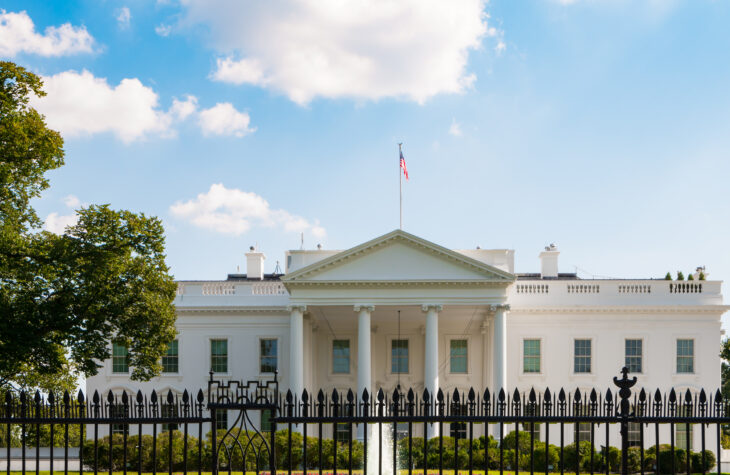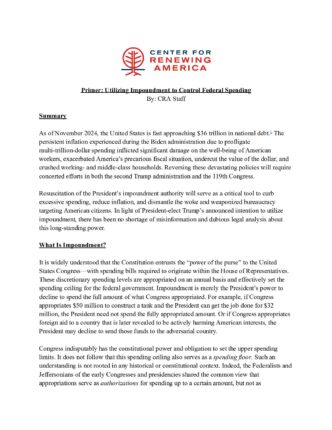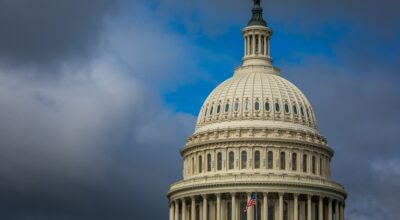
Primer: Utilizing Impoundment to Control Federal Spending
Summary
As of November 2024, the United States is fast approaching $36 trillion in national debt.1 The persistent inflation experienced during the Biden administration due to profligate multi-trillion-dollar spending inflicted significant damage on the well-being of American workers, exacerbated America’s precarious fiscal situation, undercut the value of the dollar, and crushed working- and middle-class households. Reversing these devastating policies will require concerted efforts in both the second Trump administration and the 119th Congress.
Resuscitation of the President’s impoundment authority will serve as a critical tool to curb excessive spending, reduce inflation, and dismantle the woke and weaponized bureaucracy targeting American citizens. In light of President-elect Trump’s announced intention to utilize impoundment, there has been no shortage of misinformation and dubious legal analysis about this long-standing power.
What Is Impoundment?
It is widely understood that the Constitution entrusts the “power of the purse” to the United States Congress—with spending bills required to originate within the House of Representatives. These discretionary spending levels are appropriated on an annual basis and effectively set the spending ceiling for the federal government. Impoundment is merely the President’s power to decline to spend the full amount of what Congress appropriated. For example, if Congress appropriates $50 million to construct a tank and the President can get the job done for $32 million, the President need not spend the fully appropriated amount. Or if Congress appropriates foreign aid to a country that is later revealed to be actively harming American interests, the President may decline to send those funds to the adversarial country.
Congress indisputably has the constitutional power and obligation to set the upper spending limits. It does not follow that this spending ceiling also serves as a spending floor. Such an understanding is not rooted in any historical or constitutional context. Indeed, the Federalists and Jeffersonians of the early Congresses and presidencies shared the common view that appropriations serve as authorizations for spending up to a certain amount, but not as requirements to spend that amount.2 The congressional power of the purse is a restriction on overspending, not a prohibition on underspending.
The Constitution vests the entirety of executive power in the President. The impoundment power is a longstanding part of this grant of executive power. It is also a necessary part of the President’s obligation to take care that the laws are faithfully executed, and of his Commander in Chief and foreign affairs authority. Impoundment enables the President to respond to emergencies, faithfully execute the laws, and ensure good government and reasonable implementation of federal programs.3 For nearly 200 years, the President’s impoundment authority was undisputed.
It was not until the Nixon administration—at the height of the Watergate scandal—that this authority was stripped from the President with passage of the Impoundment Control Act (ICA) of 1974.4 The ICA neutered impoundment, providing that the President can only temporarily delay appropriations as part of a policy review or issue a rescission request for congressional approval to cut the money they have already made clear they want to spend. The ICA’s restrictions are an unconstitutional abridgment of the President’s Article II impoundment authority.
The ICA is Unconstitutional:
- 1. Redefining Appropriations: The ICA radically warps the Appropriations Clause in the U.S. Constitution, which is expressly phrased as a ceiling (“No Money shall be drawn from the Treasury, but in Consequence of Appropriations made by Law”), into a spending floor. In doing so, it nullifies the longstanding Executive power to decline to spend the total amount of permissible appropriated money in a particular fund.5
- 2. Separation of Powers Infringement: The ICA seizes power for the Legislative Branch in a manner that excises the ability of the Executive Branch to effectively enforce the laws—to the point where agencies cannot even pause spending to better ascertain how to use appropriated funds without invoking statutory triggers predicated on congressional notification.6 It also purports to intrude upon the President’s broad foreign affairs and military powers by attempting to limit the President’s ability to use foreign aid as a tool of foreign policy and authority to make force-structuring decisions for the military.
- 3. Executive Power of the Comptroller: The ICA vests executive power in an employee of the Legislative Branch—the Comptroller of the Government Accountability Office (GAO). Empowering a legislative officer with executive authority to enforce the statutes of the ICA is a clear power grab and a blatant violation of the constitutional parameters granted to the Legislative Branch.7
Prior to the congressional overreach embodied by passage of the ICA, impoundment was a widely recognized and utilized power. For example, in 1803, President Thomas Jefferson used his impoundment authority to refuse to spend $50,000 in congressional appropriations for the construction of 15 gunboats for the Mississippi River. He did this on pure policy grounds, seeking not to provoke the French as he was in negotiations for the Louisiana Purchase.8 In 1809, President James Madison used his impoundment authority to reduce the size of gunboat crews despite congressional appropriations to the contrary.9 In 1876, President Ulysses Grant impounded more than $2.5 million in congressional appropriations for river and harbor infrastructure development.10 During the height of World War II, President Franklin Roosevelt refused to spend more than $500 million in congressional appropriations with his impoundment authority.11 In 1961, President John F. Kennedy impounded $180 million in congressional appropriations for the B-70 strategic bomber due to a belief that ICBM capabilities negated the need for such spending.12
Conclusion
Impoundment has a long history as a power vested in the Executive Branch to faithfully execute the law. The characterization of impoundment by some leftwing activists as an action “in defiance of federal law” reveals that the primary argument against this authority is rooted in the deeply flawed view that somehow legislative statute supersedes the Constitution. It does not.
If America’s national debt is to be brought to heel, inflation tamed, and deficits eliminated, the constitutional power of the Executive Branch to impound funds is a critical tool to accomplish this task. The incoming Trump administration and its allies in the United States Congress should welcome efforts to restore this balance of power and finally bring fiscal sanity back to Washington, D.C.
Read More:
The President’s Constitutional Power of Impoundment
The History of Impoundments Before the Impoundment Control Act of 1974
Endnotes
1. United States Debt Clock (November 8, 2024). “United States National Debt,” U.S. Debt Clock. https://www.usdebtclock.org/
2. Paoletta, M. and Shapiro, D. (September 10, 2024). “The President’s Constitutional Power of Impoundment,” Center for Renewing America. https://americarenewing.com/the-Presidents-constitutional-power-of-impoundment/.
3. Ibid.
4. Bale, C. (2020), “Checking the Purse: The President’s Limited Impoundment Authority,” Duke Law Journal Vol. 70. https://scholarship.law.duke.edu/cgi/viewcontent.cgi?article=4048&context=dlj
5. Paoletta, M. and Shapiro, D. (September 10, 2024). “The President’s Constitutional Power of Impoundment,” Center for Renewing America. https://americarenewing.com/the-Presidents-constitutional-power-of-impoundment/
6. Ibid.
7. Ibid.
8. Paoletta, M., Shapiro, D., and Stras, B. (June 24, 2024). “The History of Impoundments Before the Impoundment Control Act of 1974,” Center for Renewing America. https://americarenewing.com/the-history-of-impoundments-before-the-impoundment-control-act-of-1974/
9. Ibid.
10. Ibid.
11. Ibid.
12. Ibid.




